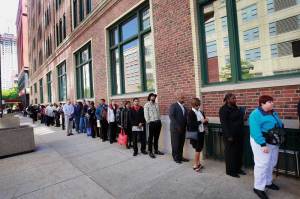
If you are a frequent reader of my writings, you know that I believe that employment data is the metric that most profoundly affects the fundamentals of real estate. Those who have lost a job, or feel they may lose a job, don’t move out of Mom and Dad’s house, don’t upgrade from a one-bedroom apartment to a two-bedroom and don’t decide to move out of a rental unit to buy a home. Similarly, companies that are downsizing don’t take more office space; they need less. For these reasons, employment trends are critically important to our real estate market.
The numbers confirm that there are still eight million fewer workers on payrolls than when the recession began in late 2007. Furthermore, 46 percent of those who are unemployed have been out of work for more than six months; this is the highest percentage than at any time since the Labor Department began keeping such records in 1948.
Because of the important link, last Friday’s jobs report was extremely troubling. The Labor Department announced that in May, 431,000 jobs were added. Additionally, the U.S. jobless rate dropped from 9.9 percent in April to 9.7 percent in May. On face value, these two points appear positive. In fact, they led to unprecedented, simultaneous announcements by both the president and vice president in speeches, last Wednesday and Thursday, that the jobs report to be released on Friday would be wonderful and that they would “knock your socks off.” These pronouncements elevated political spin to new levels.
The fact is, unfortunately, that the vast majority (411,000) of the 431,000 jobs that were created were temporary positions, consisting of 2010 census workers hired by the government. The private sector created only 41,000 positions, the smallest monthly increase since January. With regard to the unemployment rate, the drop is due overwhelmingly to these temporary government workers and a growing number of discouraged workers dropping out of the job market. Job seekers who have stopped looking for work for more than 30 days are no longer considered unemployed. The U-6 unemployment rate, which takes these people into consideration, as well as part-timers who would rather be employed full time, remains more than 17 percent.
The numbers presented by the Labor Department in May confirm that there are still eight million fewer workers on payrolls than when the recession began in late 2007. Furthermore, 46 percent of those who are unemployed have been out of work for more than six months; this is the highest percentage than at any time since the Labor Department began keeping such records in 1948.
Employers are simply getting more productivity out of existing workforces rather than hiring new people. This is illustrated by the fact that the average work week for employees on private payrolls rose to 34.2 hours in May from 34.1 hours a month earlier.
This disappointing jobs report sent the Dow tumbling 324 points, or 3.15 percent, to close below 10,000 for the second time in two weeks. Its closing level, at 9,931.97, was the lowest close since Feb. 8.
The growth in census worker jobs is also somewhat misleading. Often, census workers are hired for just a few hours per month, and after working two hours in one week, they may receive an official termination notice. The following week, if they are called back to work, they fill out a new application and may get three hours work the following week, which is followed by another termination notice. The same worker may get rehired again for a few hours the following week and then get terminated again, and so on and so on.
Each time a worker is fired and then rehired, the government counts this as another job created. This results in a dynamic where the same worker may have worked only for seven hours over a period of time and could be counted as four or six new “jobs created.” This is hardly something that has a significant impact on our economy going forward.
The sluggish real jobs numbers lead us to ask the question, “Why aren’t employers hiring?” There are several reasons, but two factors contribute the most: the lack of credit available to small businesses and the anticipation that tax burdens are going to increase substantially in the future. Add to these the uncertainties in economies all over the globe, and the incentives for job creation are difficult to find.
States and municipalities across the nation are facing record budget deficits and, with only few exceptions, politicians have not demonstrated the will to make tough choices about spending cuts. We are seeing this on a national basis, and it is extraordinarily acute here in the Empire State.
Last year, the state received more than $7 billion in stimulus money, and rather than use this cash to pay existing expenses, Albany increased existing spending by this $7 billion. Moreover, an additional $4 billion of new spending was added to the budget total. An obscene 137 new or increased taxes, fees and charges were imposed to attempt to raise revenue to meet all of the new spending.
Tax revenue, not surprisingly, was insufficient to cover the spending, and New York State is now facing a $9.2 billion budget deficit. Common sense would dictate that budget cuts were necessary. However, common sense is sometimes elusive. As we have seen, once spending initiatives are established by municipalities, it is extremely difficult to get those line items reduced or out of a budget.
Unfortunately for residents of New York, the first rule of politics is to get reelected. Given the upcoming elections in November, none of our legislatures are prepared to propose or support cuts. With education and health care spending representing more than 50 percent of New York State’s budget, it is inconceivable that a balanced budget can be reached without significant cuts in both of these areas. While there have been some attempts made to delay union raises, furlough workers or share in concessions, these advances have been met with staunch resistance. Therefore, we can anticipate significant job losses in the public sector moving forward. These cuts, while painful, may be necessary to bridge budget gaps.
It is expected that Congress will allow the Bush tax cuts to sunset at the end of this year, providing a significant increase to our tax burden. The plan will raise the tax rate on 75 percent of “carried interest” income from 15 percent to approximately 35 percent next year, and above 38 percent in 2013.
Obamacare is something that has employers concerned as well. Those who support the program insist that the law will significantly benefit small businesses through a tax credit. In reality, the tax credit is very limited, not to mention temporary. When the credit burns off, small businesses will be left holding the bag for the entire cost.
Is there any wonder that job growth is not progressing at a quicker rate? Does anyone really believe that tax burdens are not going to be significantly increased in the future?
When federal taxes rise in 2011, residents of New York City will have tax obligations potentially exceeding 52 percent of gross income. In order to refrain from raising taxes, elected officials will have to demonstrate the backbone to make tough but necessary decisions. If this occurs, the private sector may regain the confidence to create more jobs. If it doesn’t occur, we could be slogging along with below-trend growth for a very long time. Real estate fundamentals are profoundly tied to employment. For the sake of growth within the real estate market, let’s hope we see some backbones emerge sooner rather than later.
rknakal@masseyknakal.com
Mr. Knakal is the chairman and founding partner of Massey Knakal Realty Services and has brokered the sale of nearly 1,075 properties in his career, having an aggregate market value in excess of $6.3 billion.


